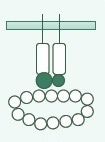The immune system plays a dual role in inflammation and cancer development. Immune system effector cells quickly identify and destroy malignant cells, but immune system-mediated inflammation regulates numerous cell functions, inhibits the antitumor response, and influences subsequent treatment.1
Cell adhesion molecules act in the form of receptor-ligand binding. They are the foundation of critical pathological and physiological processes such as inflammation, immune response, wound healing, coagulation, and tumor metastasis.
Cell adhesion molecules are classified into four families according to their structural properties. These are integrins, the immunoglobulin superfamily (IgSF), selections, and cadherins.2 Integrins and IgSF CAMs do not require calcium, whereas cadherins and selectins do.
The cytoskeleton and extracellular matrix3 interact through the heterodimer receptors known as integrins. IgSF is a large protein superfamily involved in the processes of binding and recognition. Selectins have three family members P-selectin, E-selectin, and L-selectin.
During development, cadherins play a crucial role in regulating tissue integrity and selective cellular aggregation and rearrangement.4 Table 1 lists the four primary cell adhesion molecules’ structural and functional characteristics.
Table 1. Functional Properties of the Four Cell Adhesion Molecule Families. Source: Sino Biological Inc.
| |
Calcium-independent Cell Adhesion Molecules |
Calcium-dependent Cell Adhesion Molecules |
| Family |
Integrins |
IgSF CAMs |
Selectins |
Cadherins |
| Members |
ITGA5 & ITGB1
LFA-1 (αLβ2)
ITGAV
ITGB1 |
ICAM1
NCAM
VCAM1
PECAM1 |
E-Selectin
P-Selectin
L-Selectin |
E-Cadherin
P-Cadherin
N-Cadherin
VE-Cadherin |
| Type |
 |
 |
 |
 |
| Interaction |
Heterophilic |
Homophilic
Heterophilic |
Heterophilic |
Homophilic
Heterophilic |
The role of CAM in immune response
CAMs are essential components of active T cells that play a role in controlling inflammation. In patients with leukocyte adhesion deficiency type I (LAD-I), β2 integrin expression is absent or decreased in leukocytes. Patients with leukocyte adhesion deficiency type III (LAD-III) have integrin expression; however, it is dysfunctional.
The symptoms of these patients are similar to LAD-1 patients. Integrins and their cytoplasmic regulators are essential inflammation regulators.5,6
Essential mediators of immune cell interactions include cell adhesion molecules. For instance, LFA-1 increases IL-2 gene expression and sends costimulatory signals to T cells.7
LFA-1 is necessary for memory T cell production, the development of follicular T cells and Tregs, and Th1/Th2 polarization.8 Cell adhesion molecules are critical T cell activators that help to protect the host from infection.
How the expression of CAMs affects the tumor-infiltrating T cells
T cells identify tumor-specific antigens, which are crucial to the antitumor immune response. In human malignancies, a high CD8+ T cells/Treg ratio and CD8+ T cell infiltration are prognostically important.9
However, T cells cannot infiltrate tumor tissue, which poses considerable challenges for cancer therapies based on immunotherapy.10 CAM expression has been found to influence tumor-infiltration T lymphocytes, according to several studies.
ICAM-1 blockade and deletion decreased CD8+ T cell infiltration in colon cancer (CT26) and melanoma (B16-OVA). ICAM-1 expression, therefore, influences the infiltration of T cells into tumors.11
αE + CD8+ T cells readily accumulate in tumors in humanized mouse breast cancer models due to αE on CD8+ T cell-specific binding of E-cadherin expressed on epithelial cancer cells.
There are varying degrees of connection between T cell infiltration and CAMs in different cancers, including glioblastoma, melanoma, squamous cell carcinoma (SCC), and Merkel cell carcinoma.
When using TLR-7 agonist treatment in patients with SCC, tumor vessels upregulate E-selectin expression. As a result, the tumor and Treg frequency significantly regress.1
Antitumor therapy targeting cell adhesion molecules
Cell adhesion molecules, a class of transmembrane glycoproteins on the cell surface, are directly linked to metastasis, tumorigenesis, and invasion. Integrins may be valuable targets for cancer treatment, according to studies.
Malignancies exhibit high levels of expression for integrins αV and β1. Antagonists of integrins αV and β1 slow the growth of tumors in preclinical mouse models. Integrins have been the subject of numerous clinical trials for cancer treatment.
In a recent phase II clinical trial, intetumumab (CNTO 95), an anti-αV integrin human antibody, was given instead of a placebo, resulting in shorter progress-free survival (PFS) and overall survival (OS).12
Integrins and other immunotherapies in combination could lead to better clinical results. For instance, combining anti-PD-L1 immunotherapy with the Fc fusion protein, which has an Fc domain and RGD-binding integrins, increases tumor growth and improves antitumor immunity.13
The angiogenesis inhibitor anginex was used to treat cancer, and this significantly upregulated the expression of VCAM-1 and E-selectin in tumor vascular endothelial cells. In a mouse model, these actions inhibited the growth of tumors.14
Studies have examined the clinical significance of E-cadherin in the invasion and metastasis of breast cancer. Normal breast tissue expresses E-cadherin; however, in patients with aggressive breast cancer, reduced E-cadherin expression is linked to lymph node metastases.
Additionally, patients with low expression had a worse prognosis than those with high expression. Furthermore, by utilizing bispecific antibodies that target LFA-1 and specific antigens,15 LFA-1-mediated tumor cell adhesion can be prevented without impairing the immune response.
Adhesion molecules research reagents
Sino Biological provides a wide range of antibodies for use in FCM, IF IHC, WB, and ELISA (Figure 2) to support research into cell adhesion molecules and their function in various cancers.

Figure 2. Featured Products including ITGAV, VCAM1, and N-Cadherin. Image Credit: Sino Biological Inc.
Recombinant proteins, ELISA kits, and other products are available as additional offerings. These high-quality reagents, which deliver consistent and reproducible findings, have been validated using various methods (Table 2).
Table 2. Recommended Cell Adhesion Molecule Proteins. Source: Sino Biological Inc.
| Cat# |
Molecule |
Species |
Activity |
Tag |
| 50440-M03H |
ICAM1 |
Mouse |
Active |
His & hFc |
| 10148-H02H |
PEAM1 |
Mouse |
Active |
hFc |
| 10673-H08H |
NCAM1 |
Human |
|
His |
| 50163-M03H |
VCAM |
Mouse |
Active |
His & hFc |
| 50736-M02H |
E-Selectin |
Mouse |
Active |
hFc |
| 50045-M03H |
L-Selectin |
Mouse |
Active |
hFc & His |
| 80451-R02H |
P-Selectin |
Rat |
Active |
hFc |
| 10204-H02H |
E-Cadherin |
Human |
Active |
hFc |
| 10915-H08H |
P-Cadherin |
Human |
Active |
His |
| 11039-H08H |
N-Cadherin |
Human |
Active |
His |
| CT016-H2508H |
ITGA8 & ITGB1 |
Human |
|
Flag & His |
| CT098-H08H |
ITGAV & ITGB3 |
Human |
|
His |
Conclusion
The immune response and anti-immunity are strongly influenced by cell adhesion molecules. Additionally, these molecules mediate crucial functions in cell proliferation, activation, and tumor growth during tumor treatment.
Studies of immune checkpoint blockades, CAR T cells, and cancer immunotherapy have ushered in new treatments for various malignancies over the past decade. Integrins are promising new additions to cancer treatment.
Unfortunately, clinical trials have thus far produced inconsistent findings and little therapeutic efficacy. Despite this, integrins are still a subject of significant interest, and studies into their use as treatment targets are ongoing.16
References
- doi: 10.3389/fimmu.2019.01078
- doi: 10.1007/s00018-014-1763-4
- doi: 10.1038/s41390-020-01177-9
- doi: 10.1111/j.1440-169X.2008.01002.x
- doi: 10.1016/j.coi.2009.07.005
- doi: 10.3389/fimmu.2019.00254
- doi: 10.4049/jimmunol.167.9.5193
- doi: 10.3389/fimmu.2018.00952
- doi: 10.1073/pnas.0509182102
- doi: 10.1158/0008-5472.CAN-08-228
- doi: 10.1172/JCI44952
- doi: 10.1093/annonc/mds505
- doi: 10.1084/jem.20160831
- doi: 10.1096/fj.05-4493com
- doi: 10.4049/jimmunol.170.5.2695
- doi: 10.3390/cancers11070978
About Sino Biological Inc.

Sino Biological is an international reagent supplier and service provider. The company specializes in recombinant protein production and antibody development. All of Sino Biological's products are independently developed and produced, including recombinant proteins, antibodies and cDNA clones. Sino Biological is the researchers' one-stop technical services shop for the advanced technology platforms they need to make advancements. In addition, Sino Biological offers pharmaceutical companies and biotechnology firms preclinical production technology services for hundreds of monoclonal antibody drug candidates.
Sino Biological's core business
Sino Biological is committed to providing high-quality recombinant protein and antibody reagents and to being a one-stop technical services shop for life science researchers around the world. All of our products are independently developed and produced. In addition, we offer pharmaceutical companies and biotechnology firms preclinical production technology services for hundreds of monoclonal antibody drug candidates. Our product quality control indicators meet rigorous requirements for clinical use samples. It takes only a few weeks for us to produce 1 to 30 grams of purified monoclonal antibody from gene sequencing.
Sponsored Content Policy: News-Medical.net publishes articles and related content that may be derived from sources where we have existing commercial relationships, provided such content adds value to the core editorial ethos of News-Medical.Net which is to educate and inform site visitors interested in medical research, science, medical devices and treatments.